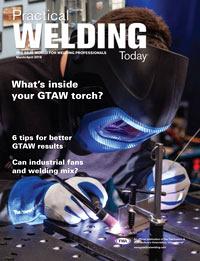Independent welding consumables professional
- FMA
- The Fabricator
- FABTECH
- Canadian Metalworking
Categories
- Additive Manufacturing
- Aluminum Welding
- Arc Welding
- Assembly and Joining
- Automation and Robotics
- Bending and Forming
- Consumables
- Cutting and Weld Prep
- Electric Vehicles
- En Español
- Finishing
- Hydroforming
- Laser Cutting
- Laser Welding
- Machining
- Manufacturing Software
- Materials Handling
- Metals/Materials
- Oxyfuel Cutting
- Plasma Cutting
- Power Tools
- Punching and Other Holemaking
- Roll Forming
- Safety
- Sawing
- Shearing
- Shop Management
- Testing and Measuring
- Tube and Pipe Fabrication
- Tube and Pipe Production
- Waterjet Cutting
Industry Directory
Webcasts
Podcasts
FAB 40
Advertise
Subscribe
Account Login
Search
Consumables Corner: Understanding welding heat input and its effects on base materials
- By Nino Mascalco, Rob Koltz, and Steve Sigler
- March 28, 2016
- Article
- Consumables
Q: Our shop primarily manufactures structural steel products, although we do produce some agricultural equipment and tanks for various liquids. In some cases, we have no information from the customer regarding welding guidelines, and in others we have detailed welding procedures. If there are no welding procedures, how important is heat input, and are there any general guidelines to follow?
A: In almost any welding application, heat input is an important variable, and you should follow a couple of guidelines to help prevent problems.
The two primary reasons for controlling heat input, specifically high heat input, are the detrimental effect on toughness or impact properties (for carbon steels) and corrosion resistance for certain types of stainless steel. The basic heat input calculation is based on voltage, amperage, and travel speed:[(Volts x Amp x 60)/(Travel speed IPM x 1,000)] x (Process efficiency)=Kilojoules/inch
Welding process efficiency is also figured into that calculation if you are trying to maximize deposition for processes such as shielded metal arc welding (SMAW) that have low deposition efficiency. In many cases, it isn't necessary to include efficiency, though.
The key to understanding the equation is that in welding the changes in voltage and/or amperage are going to be small and will have a minimal effect on the overall heat input. However, changes in travel speed can have significant effects on that value. A slow travel speed for a set voltage and amperage can result in a drastically higher heat input. For example, if a WPS specifies a travel speed of 12 to 15 inches per minute (IPM) and the welder decides to slow his travel speed to 6 IPM to fill in a large groove weld, then he has effectively doubled the heat input from the specified upper limit of the WPS. This change could result in degraded impact toughness and cause a welded structure to fail in cold-weather applications.
With stainless steels, excessive heat input or prolonged periods of high heat can cause sensitization. Depending on the grade and thickness, the ideal heat input range for stainless steel may typically fall in the 25 to 45 kJ/in. range.
Some steels such as A514, known also as T1, get their enhanced mechanical properties from a quench-and-temper heat treatment. Certain grades of these materials are also susceptible to reduced tensile and yield strength if the welding heat input is excessive.
In general, the sweet spot for welding heat input is between 35 and 65 kJ/in. Keep in mind, though, that you need to review each application to determine the specific limitations. Many of the mild steels on the market, such as A36, aren't greatly affected by high heat input. Some steels can withstand values well over 120 kJ/in. while others may have an upper limit of 45 kJ/in.
Likewise, many filler metals, and especially those developed for improved cold weather impact toughness, are also susceptible to degraded performance.
Conversely, welding heat input that is too low can also cause problems. Welding on heavy sections of steel with low heat input or small welding beads can cause the welds to cool too quickly, producing above-normal hardness values in the heat-affected zone (HAZ) or in the weld bead. Some welding codes have minimum heat input requirements to ensure proper weld fusion and prevent excessive hardness in the weld metal or HAZ.
Overall, the base material will be the primary consideration for setting limits on heat input. Beyond that the code requirements, material thickness, and in-service applications will also help guide you in determining heat input ranges.
About the Authors


Rob Koltz
Application Engineer
411 S. Ebenezer Rd.
Florence, 29501
636-485-2253
Steve Sigler
Application Engineer
411 S. Ebenezer Rd.
Florence, South Carolina 29501
636-485-2253
About the Publication
Related Companies
subscribe now

The Welder, formerly known as Practical Welding Today, is a showcase of the real people who make the products we use and work with every day. This magazine has served the welding community in North America well for more than 20 years.
start your free subscription- Stay connected from anywhere

Easily access valuable industry resources now with full access to the digital edition of The Fabricator.

Easily access valuable industry resources now with full access to the digital edition of The Welder.

Easily access valuable industry resources now with full access to the digital edition of The Tube and Pipe Journal.
- Podcasting
- Podcast:
- The Fabricator Podcast
- Published:
- 04/16/2024
- Running Time:
- 63:29
In this episode of The Fabricator Podcast, Caleb Chamberlain, co-founder and CEO of OSH Cut, discusses his company’s...
- Trending Articles
Sheffield Forgemasters makes global leap in welding technology

Welding student from Utah to represent the U.S. at WorldSkills 2024

Lincoln Electric announces executive appointments

Engine-driven welding machines include integrated air compressors

ESAB unveils Texas facility renovation

- Industry Events
16th Annual Safety Conference
- April 30 - May 1, 2024
- Elgin,
Pipe and Tube Conference
- May 21 - 22, 2024
- Omaha, NE
World-Class Roll Forming Workshop
- June 5 - 6, 2024
- Louisville, KY
Advanced Laser Application Workshop
- June 25 - 27, 2024
- Novi, MI



























